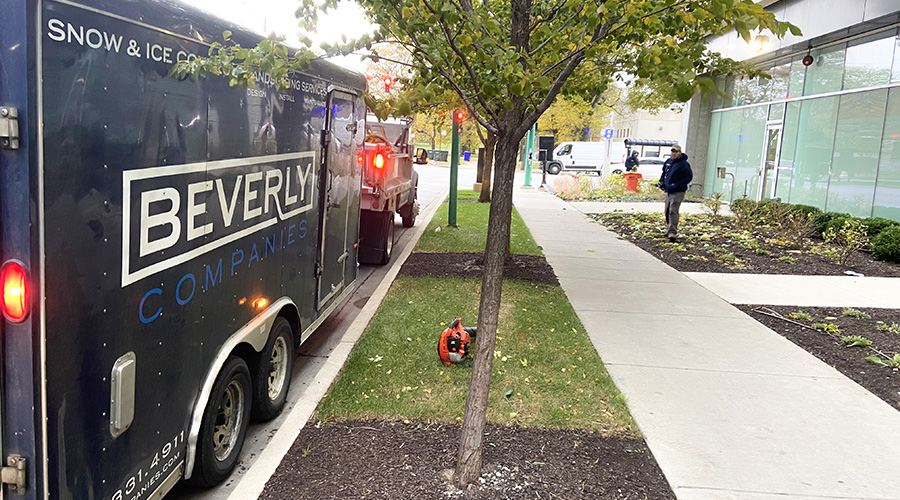Large-Scale Grounds Care
Complex landscaping and light-construction projects require more attention to schedules and equipment
As organizations expand and pay greater attention to the role that grounds play in shaping the organization’s public image, grounds managers often have to plan projects and activities that go beyond traditional tasks that include mowing, edging and trimming.
Before undertaking more complex landscaping and light-construction projects, managers need to consider several issues, including the project’s scope, staff schedules, and equipment needs.
In or Out?
One of the first steps is determining whether a grounds care department or a hired contractor should handle the project.
“It is always better for a department to do a project in-house whenever possible,” says Jim Coffey, manager of landscaping services at Wake Forest University in Winston-Salem, N.C. The department’s 35 employees maintain the campus’s 648 acres. “Anytime we can do something internally, we do it because it gives our department a greater sense of ownership.”
Managers also might want in-house staff to complete the project to ensure success.
“One of the advantages of us doing the project is that we know how it should be done,” says Roger Conner, building and grounds supervisor for University of Virginia Health System in Charlottesville, whose 16-person staff maintains the campus’s 150 acres. “Since we are the ones who have to maintain the grounds, we’ll take the extra time to do the job right.”
Contractors might be more concerned about getting the job done quickly than in taking measures to ensure long-term success. For example, contractors who are hired to plant shrubs might dig holes barely big enough for the plants so they can finish the job quickly.
Staffing Issues
Managers also need to carefully consider the knowledge and skills that a project requires before determining who should complete the tasks.
“Know what you are getting into,” Conner says. “You want to take on projects you know your department can handle successfully. I leave tasks that I am not good at to the experts and use contractors for those parts of the project.”
Before undertaking a large project, managers should review the plans carefully and identify tasks that staff has never performed before. Staff training might be necessary, but if it is not feasible, managers might be wiser to hire a contractor.
“Try to learn whatever skills are necessary before you start a project, not during a project,” Conner says. If workers try to learn during a project and do the job incorrectly, it could be costly to fix the damage. Also, the grounds care department’s credibility is at stake.
“The last thing you want to do is start a project for a customer and have it appear like you don’t know what you’re doing,” Conner says. Large projects also tend to require a variety of skills and experience.
“A big grounds care project really involves everybody from landscape designers to electricians to irrigation experts to construction workers,” Coffey says.
Landscaping projects also require a range of skills, and the equipment and technology changes constantly.
“You have to be part plumber, part electrician and computer genius to figure out some of the irrigation systems.” Conner says. To ensure that a grounds care department is prepared to handle a complex project, managers need to keep worker skills in mind during the hiring process.
“I try to hire staff with a variety of backgrounds, such as turf, gardening, horticulture, design, equipment operation, irrigation or pesticides,” Conner says. “That way, I have an expert in every area.”
When managers decide to take on large or complex projects, they also need to consider staff schedules. Addressing scheduling issues before workers begin the project can help ensure the department also can perform routine tasks, such as mowing and edging. Hiring temporary help might be one solution to meeting project deadlines and keeping up with regular work.
“When we take on a big project, we hire additional students to help relieve some of the routine maintenance,” says Pete Bemis, assistant physical plant director at the University of Wisconsin-La Crosse. “Then we can assign some of our more skilled workers to the special job.”
Summer is the ideal time for Bemis’ department to undertake large projects because fewer people are walking around the 120-acre campus during those months. Just before the summer season, his department usually hires about 12 students to fill temporary positions. This strategy has been essential for the success of his department, which typically has only seven full-time grounds workers to maintain the campus.
Early Involvement
Because large-scale projects usually involve several individuals and departments, experienced grounds managers suggest getting involved during the initial planning stages and meeting regularly with all parties.
“One of the things I learned is that as soon as you get word that the organization is planning to do a bigger project, you have to get into your boss’s office and indicate that you want to get involved,” Bemis says. “You have to get your statements in early in the design process. Otherwise, the project gets to far in the planning stages and the (decision makers) won’t want to change things in response to your input.”
By getting involved early in process, managers also protect existing landscaped areas from damage.
“A construction crew can do damage to the existing landscape, and there might not be money to make repairs,” Bemis says.
Planning is easier when the organization has a good master plan, Coffey says.
“We work from a wonderful master plan that the university created about 10 years ago,” he says. “Our master plan has made it is easy for us to sit down with higher administration and allow them to envision the finished job. Because of the plan, we already know what we want conceptually. It’s just a matter of fine-tuning it and implementing the plan when the time comes.”
Good communication and planning also can help organizations avoid costly mistakes. Six months after completing a major landscape renovation, Conner’s organization began planning another construction project on the same site. To accommodate the second project, his department removed 400 boxwood shrubs and an 8-inch tree.
“We had to plant them somewhere else and maintain them until the second project was complete, which took about a year and a half,” he says. “Then we had to dig them up again, bring them back to the site and redo the landscape the same way it was before we did the second project. I think if there was proper communication, we would have done the original project and the second project without adding the plant material,” he says. The replanting project stressed the shrubs and caused about 30 of them to die.
A long-term landscaping and construction plan also can help organizations that are expanding quickly.
“In order to compete, our organization has to continuously expand, which means the grounds are constantly changing,” Conner says. Once a project is under way, it is important for managers to stay informed on new developments.
“When I’m involved in a big project, everyone involved sits down once a week for meetings,” Coffey says. “We talk about where are we on the project, if are we on time, and other issues, such as if materials are going to be delivered on time.”
Tools of the Trade
Finally, before beginning a large-scale project, managers must determine if the department needs to buy or rent equipment to complete the project efficiently and cost-effectively.
“There is always a piece of equipment that can make a job easier,” Conner says. Managers need to decide if the equipment they’re considering is worth its cost and if it is really necessary to complete the project. Managers also should discuss major equipment purchases with operators and mechanics.
“We never buy anything we haven’t demonstrated on campus first,” Bemis says. “If our operators aren’t comfortable with it, they’re not going to drive it.”
By looking at all issues surrounding large-scale projects, managers can ensure their departments are not involved in projects they are not prepared to handle.
Related Topics:











